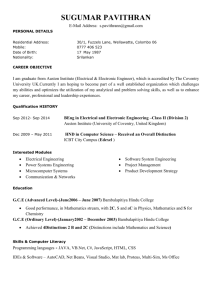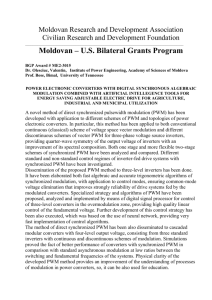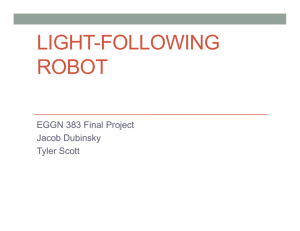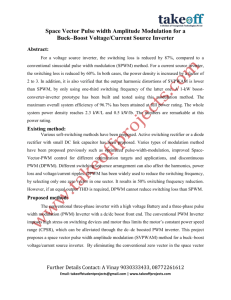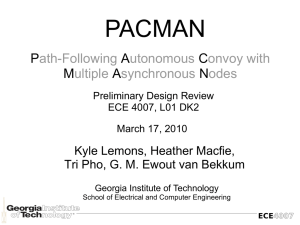OUfl ti
advertisement
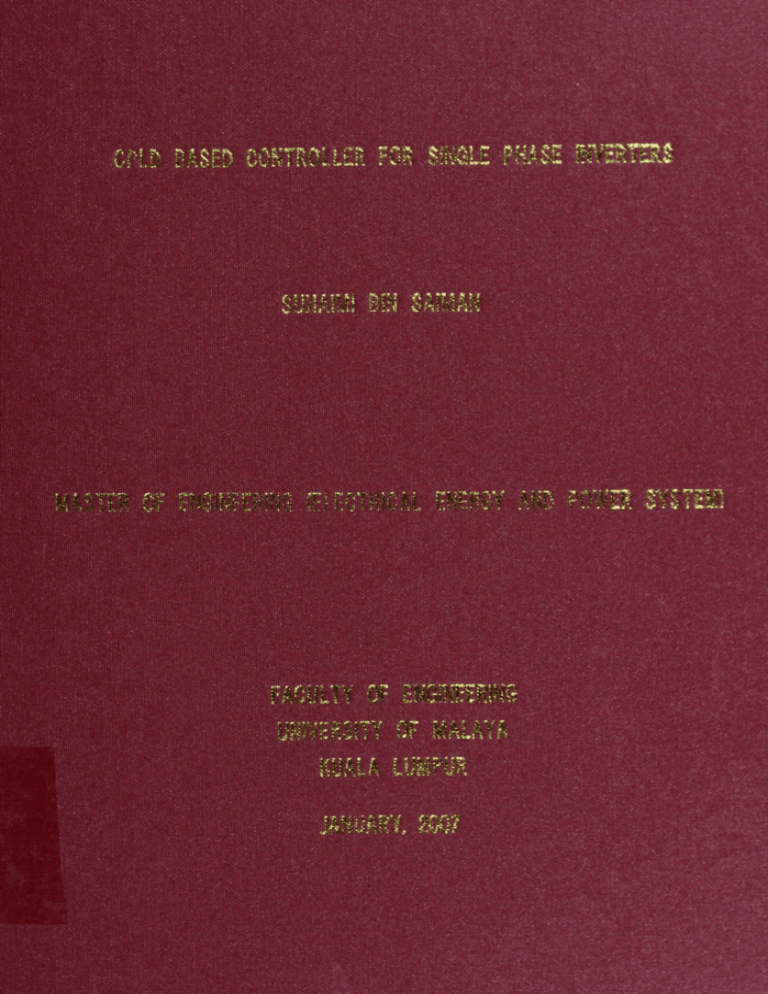
; .•,•< !..;,•.. OUfl t i •• } ? >• «»• • ' •i ^ s • ,«s.f.S A *• -« 5 «J ?: r ciiiir'JyJt 'ihi'C ; < ; 1 ' ' V . i . ;•« t- I « ' *; »•* • c CPLD BASED C O N T R O L L E R FOR SINGLE PHASE INVERTERS SUHAIMI BIN SAIMAN This thesis is submitted as partial fulfillment of the requirements for the award of the Master of Engineering (Electrical Energy and Power System) Faculty of Engineering University of Malaya January, 2007 UNIVERSITY MALAYA UNIVERSITY MALAYA ORIGINAL LITERARY W O R K DECLARATION Name of Candidate: SUHAIMI BIN SAIMAN (I.C/Passport No: 710627-01-5967) Registration/Matric No: KGD 020002 Name of Degree: MASTER OF ENGINEERING Title of Project Paper/Research Report/Dissertation/Thesis ("this Work"): CPLD BASED C O N T R O L L E R FOR SINGLE PHASE INVERTERS Field of Study: E L E C T R I C A L ENERGY AND P O W E R SYSTEM 1 do solemnly and sincerely declare that: (1) 1 am the sole author/writer of this work. (2) This Work is original. (3) Any use of any work in which copyright exists was done by way of fair dealing for permitted purposes and any excerpt or extract from, or reference to or reproduction of any copyright work has been disclosed expressly and sufficiently and the title of the of the Work and its authorship have been acknowledged in this Work. (4) I do not have any actual knowledge nor ought I reasonably to know that the making of this work constitutes an infringement of any copyright work. (5) I hereby assign all every rights in the copyright to this Work to the University of Malaya ("UM"), who henceforth shall be the copyright in this Work and that any reproduction or use in any form or by any means whatsoever is prohibited without the written consent of UM having been first had and obtained. (6) I am fully aware that if in the course of making this Work I have infringed any copyright whether intentionally or otherwise, I may be subject to legal action or any other action as may be determined by UM. Candidate's Signature Date Subscribed and solemnly declared before, Witness's Signature Date Name: Designation: iii ACKNOWLEDGEMENT In the name of Allah, the most Gracious and most Compassionate First of all, I would like to thank Allah Almighty for blessing and giving me strength to accomplish this thesis. I also would like to acknowledge Dr. Saad Mekhilef for his continuous guidance, help and encouragement through out the work. Many of my accomplishments would not been realize without his dedication to work hard. The grateful thank to Universiti Tun Hussein Onn Malaysia (UTHM) in providing me the financial assistant along the period of my study in this university. Special thank and appreciation goes to all my friends, technicians whose in charge the laboratory, and peoples either in UM or UTHM for their help at various occasion. Lastly, my warmest thanks go to my parent and parent-in-law for their support. My highest appreciation goes to my loving wife, Amelia Kamijan, and all my loving children, Nurin Syaza Amani, Muhammad Ammar Syazwi and Muhammand Akif Syahmi for their unconditional support and love that continuously fed my strength desire to succeed. iv ABSTRACT The DC-AC converter, also known as inverter, converts DC power to AC power at desired output voltage and frequency. The DC power input to the inverter is obtained from an existing power supply. Nowadays inverters use high power switching transistors either IGBT's and/or MOSFETs. In addition, the voltage and frequency of the source can be adjustable. These single phase inverters and their operating principles are analyzed in detail. In this project, a full-bridge, single phase inverter that uses a digital Pulse Width Modulation (PWM) to control the power switches at 18 kHz was constructed. The concept of PWM with different strategies for inverters is described. A type of filter is used to improve the distortion in the output waveform. A design and implementation of PWM by using complex programmable logic device (CPLD) from Altera MaxPlus II is constructed and programmed. The involved software, hardware, and suitable algorithm to implement and generate the PWM are developed in details. To verify the significant of this single phase inverter, the output voltage will be tested with resistive load and inductive load. \ TABLE O F CONTENTS ORIGINAL LITERARY W O R K DECLARATION ii ACKNOWLEDGEMENT iv ABSTRACT v TABLE O F C O N T E N T S vi LIST O F TABLES xi LIST O F F I G U R E S xii LIST OF SYMBOL AND ABBREVIATIONS xvi LIST O F APPENDICES xix CHAPTER 1 INTRODUCTION 1 1.0 Introduction to Power Electronics 1 1.1 Significance of Power Electronics 2 1.2 Power Semiconductor Devices 2 1.3 Power Converters 5 1.4 Pulse Width Modulation 8 1.5 Harmonics 9 1.5 Objectives of the Project 10 1.6 Organization of the Dissertation 11 References 12 vi CHAPTER 2 LITERATURE REVIEW 14 2.0 Introduction 14 2.1 Inverter Topologies 15 2.2 Voltage Control in Inverters 15 2.3 Analog Circuits 18 2.4 Digital Control Circuit 19 2.5 Digital PWM Controller 20 2.5.1 Digital Design Approaches 22 2.5.2 Impact of Digital Control 22 2.6 High Frequency Switching 23 2.7 Complex Programmable Logic Device (CPLD) 25 References CHAPTER 3 27 PULSE W I D T H MODULATION 33 3.0 Introduction 33 3.1 Sinusoidal PWM 36 3.2 Digital PWM Technique 40 3.3 Symmetrical Sampling PWM 40 3.4 Asymmetrical Sampling PWM 42 References 44 vii CHAPTER 4 P R O G R A M M A B L E L O G I C DEVICE 46 4.0 Introduction 46 4.1 Digital Logic Design 47 4.1.1 Techniques of Traditional Digital Circuit Design 49 4.1.2 Integrated Digital Logic Design 50 4.2 Comparison of Traditional and Integrated Digital Design 51 4.3 FPGAs AND CPLDs 53 4.4 Altera CPLD 55 4.5 Significance of CPLD 57 References CHAPTER 5 58 M O D E L L I N G AND S I M U L A T I O N O F D I G I T A L PWM INVERTER 59 5.0 Introduction 59 5.1 Generating PWM 60 5.2 The Carrier Waveform 63 5.3 The Sinusoidal Waveform 66 5.4 Symmetrical Sinusoidal PWM 71 5.5 Asymmetrical Sinusoidal PWM 72 5.6 Comparator 73 5.7 Adjusting Modulation Index 74 5.8 Generated PWM 76 80 References CHAPTER 6 HARDWARE IMPLEMENTATION 6.0 Introduction 6.1 Inverter Circuit 6.2 Altera MaxPlus II University Program (UP) Board 6.3 Using Altera FLEX 1 OK 6.4 The Modulator 86 6.5 Gate Driver S6 6.6 LC Filter S7 6.7 DC-Link Capacitor 89 6.8 Snubber Circuit 90 References 83 84 85 91 CHAPTER 7 SIMULATION AND EXPERIMENTAL RESULTS 92 7.0 Introduction 92 7.1 Oread Simulation 92 7.2 Hardware Experimental 7.2.1 Results of Altera MaxPlus II Simulation 97 7.2.2 Results of Hardware Experimental 98 ix 7.3 Total Harmonic Distortion (THD) CHAPTER 8 CONCLUSION 103 105 8.0 Concluding Remarks 105 8.1 Author's Contribution 106 8.2 Area for Future Works 107 Appendix A 108 Appendix B ]]3 x LIST OF TABLES No. of tables Titles Table 4.1 Comparison of PLD. Standard or Discrete Logic, and Pa 8es 49 Full- Custom IC. Table 4.2 (a) Comparisons of traditional and integrated digital by tools. 51 Table 4.2 (b) Comparisons of traditional and integrated digital by 52 elements. Table 4.2(c) Comparisons of traditional and integrated digital by 52 circuit design flow. Table 4.2(d) Comparisons of traditional and integrated digital by study 53 requirement. xi LIST O F F I G U R E S No. of figures Figure 2.1 Titles DC to AC conversion system: (a) single phase, (b) and 15 three phase. Figure 2.2 Analog circuit design trade-offs. 19 Figure 3.1 PWM signals of varying duty cycles. 34 Figure 3.2 Analog carrier based PWM technique. 36 Figure 3.3 Saw-tooth PWM. 37 Figure 3.4 Sinusoidal Pulse Width Modulation (SPWM). 38 Figure 3.5 Determining the width of SPWM. 39 Figure 3.6 Symmetrical PWM. 41 Figure 3.7 Asymmetrical PWM. 42 Figure 4.1 Digital Logic Designs. 47 Figure 4.2 MAXPLUS II functional diagram and design flow. 55 Figure 5.1 PWM block diagram. 61 Figure 5.2 PWM design using ALTERA MAX+Plus II. 62 Figure 5.3 Determining the U/D counter clock frequency. 63 Figure 5.4: Generating carrier waveform. 64 Figure 5.5 VHDL codes for U/D counter. 65 Figure 5.6 Sampling symmetrical SPWM. xii Figure 5.7 Sampling asymmetrical SPWM. Figure 5.8 (a) Graph obtained from data sampled. /TQ 70 Figure 5.8 (b) Sample data from MathCAD. Figure 5.9 Symmetrical SPWM. 71 Figure 5.10 Asymmetrical SPWM. 72 Figure 5.11 VHDL code for comparator. 74 Figure 5.12 VHDL code for multiplier. 75 Figure 5.13 Single Phase full bridge inverter. 76 Figure 5.14 PWM switching pattern. 77 Figure 5.15 PWM pattern with MaxPlus II simulation. 78 Figure 6.1 Block diagram of overall interconnection of PWM and 82 inverter. Figure 6.2 Full bridge inverter circuit. 83 Figure 6.3 The outline of UP board unit 84 Figure 6.4 Schematic diagram of gate driver 87 Figure 7.1 Schematic diagram of single phase full bridge inverter. 93 Figure 7.2 Schematic diagram of PWM. 93 Figure 7.3(a) Sine waveform and triangle waveform. 94 Figure 7.3(b) PWM signal. 95 Figure 7.4(a) The output inverter for resistive load. 95 Figure 7.4(b) The output inverter for inductive load. 96 Figure 7.5 Digital PWM signal. Q7 xiii 97 Figure 7.6 Sine wave signal. Figure 7.7 Carrier frequency. Figure 7.8 The PWM signal. Figure 7.9(a) Modulation index, M = 0.1 (10% of duty cycle). 99 Figure 7.9(b) Modulation index, M = 0.5 (50% of duty cycle). 100 Figure 7.9(c) Modulation index, M = 0.9 (90% of duty cycle). 100 Figure 7.10 Unfiltered output voltage waveform. 101 Figure 7.11 Filtered output voltage waveform. 101 Figure 7.12(a) With resistive load. 102 Figure 7.12(b) With inductive load. 102 Figure 7.13 Harmonic spectral for output resistive load after filter, (a) 103 98 99 simulated, (b) experimental. Figure 7.14 Harmonic spectral for output inductive load after filter, 104 (a) Simulation, (b) Experimental. Figure B1 Hardware experimental setup Figure B2 ALTERA FLEX 10K University Program Board. 114 Figure B3 Switching devices with heat sink. 115 Figure B4 Snubber unit. 116 Figure B5 Driver unit. 117 Figure B6 Low-pass filter. Figure B7 Fuse board. Figure B8 Resistive load and inductive load. 118 119 120 xiv Figure B9 Altera programming in PC. 121 Figure B10 Waveform captured using oscilloscope, 122 xv LIST OF SYMBOLS AND ABBREVIATIONS Symbols: u Micro (10"fl) Q Ohm 7T Pi (180°) Z Sum en Omega <p Phase displacement C Capacitance f Frequency k Kilo (10 3 ) L Inductor m Mili(10' 3 ) M Mega (106) 1 Switching period xvi Abbreviations: AC Alternating Current DC Direct Current THD Total Harmonic Distortion UPS Uninterruptible Power Supply CVCF Constant Voltage and Constant Frequency KV Kilo-Volt BJT Bipolar Junction Transistor TTL Transistor-transistor Logic MOS Metal Oxide Semiconductor CMOS Complementary Metal Oxide Semiconductor MCT MOS-controlled Thyristor IGBT Insulated Gate Bipolar Transistor MOSFET Metal Oxide Semiconductor Field Effect Transistor PWM Pulse Width Modulation ASIC Application Specific Integreter DSP Digital Signal Processor PAL Programmable Array Logic GAL General Array Logic CPLD Complex Programmable Logic Device FPGA Field Programmable Gate Array. VHDL Very High Digital language. HVDC High Voltage Direct Current Ma Modulation Index GTO Gate Turn-Off EDA Electronic Design Automatic SRAM Static Random Access Memory UP University Program LED Light-emitting diode ADC Analog to Digital Converter PID Proportional Integral Derivative RAM Random Access Memory RMS Root mean square THD Tottal Harmonics U/D Up Dawn MOD Modulus VFI Voltage Fed inverter CFI Current Fed inverter xviii LIST OF APPENDICES No. of appendix Titles Pages Appendix A The MathCAD data. 107 Appendix B The pictures of hardware implementation. 112 xix CHAPTER 1 INTRODUCTION CHAPTER 1 INTRODUCTION 1.0 Introduction to power electronics Power electronics can be defined as the use of electronic devices to control and convert electric power. Power electronics combine power, electronics and control. It may be defined as the applications of solid-state electronics for the control and conversion of electric power. It is based on the switching of power semiconductor devices whose power handling capabilities and switching speeds have improved tremendously over the years. The switching characteristics of power devices permit the control and conversion of electric power from one to others. Versatile circuit topologies can be found in the power electronics for different applications [1.1]. Power electronics have already found an important place in modern technology and are now used in a great variety of high-power products, including motor controls, power supplies and High Voltage Direct Current (VHDC) systems [1.1]. Power electronics is the technology associated with the efficient conversion, control and conditioning of electric power by static means from its available input form into the desired electrical output form. The goal of power electronics is to control the flow of energy from an electrical source to an electrical load with high efficiency, high availability, high reliability, small size, light weight, and low cost [1.7], 1 1.1 Significance of power electronics The demand for control of electric power exits for many years. The generation, transmission, and distribution of electric power are almost AC today, but industry, transportation, agriculture, and everyday life often demand DC power. In any technically and economically defined situation, it is necessary to provide the most suitable fonn of energy to meet the demand of user [1.3]. Power electronics can process the power in two forms, AC and DC. For AC, it can process by magnitude and frequency and for DC by only magnitude [1.4], 1.2 Power semiconductor devices Power semiconductor devices play a crucial role in the regulation and distribution of power and energy in the world. In power electronics, it is well recognized that improvement in system performance in terms of efficiency, size and weight are driven by enhancement made in semiconductor device characteristics. Overall system reliability and efficiency depends on the quality of semiconductor switches and how these devices are used. Throughout the last 50 years, power electronics technology mostly evolved with the availability of new and improved power semiconductor devices. With the development of power semiconductor technology, the power handling capabilities and the switching speed of the power devices have improved tremendously [1-1]. The most important elements of power electronics are the power semiconductor devices. A wide variety of devices are available, which made it difficult to compare them. Their 2

